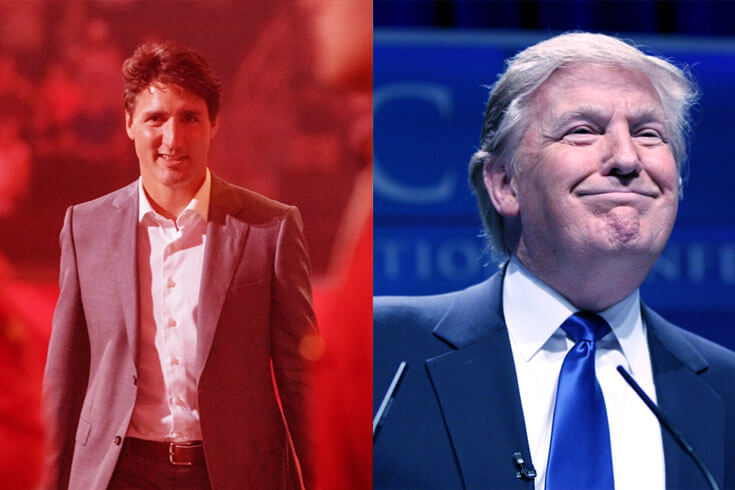The border between the United States and Canada has never been as contentious as the one between the United States and Mexico became after Donald Trump was elected president in 2016. Rather, it has frequently been called the longest undefended border in the world. On the north side lies a country with much colder average temperatures, a smidgen more area, and just over a tenth of the population—in January 2019, Canada had a population of about 37 million compared with the 328 million in the States.
Supposedly, Americans are more individualistic, violent, litigious, innovative, and open, while Canadians are more peaceful, polite, concerned about the collective welfare, and more inclined to follow orders. The received wisdom would have it that the two countries’ mottos say it all: “life, liberty, and the pursuit of happiness” versus “peace, order, and good government.” But the differences between the two countries go much deeper. At this writing, life expectancy, infant-survival rates, income equity, social mobility, and schoolchildren’s rankings on international educational tests are all higher in Canada than in the United States. On the other hand, if you want to own a weapon, pay lower taxes, or pass your winter in a place usually less snowy, the United States is the place to be.
Until recently, probably not many Americans wondered about the reasons behind those differences. Ignorance about Canada is high, despite increased interest in moving north among people upset that Trump is president. Canada is more likely to be part of the punchline of a joke: as comedian Robin Williams put it, “You are the kindest country in the world. You are like a really nice apartment over a meth lab.”
Or perhaps Canada is seen as a place to escape to in times of trouble, and not just of the recent Trumpian kind. Two stars of twentieth-century American literature—Philip Roth, in The Plot against America (2004), and Sinclair Lewis, in It Can’t Happen Here (1935)—portrayed Canada as a place where people could get away from the clutches of a fascist/brutal/racist government that has taken over the United States. Canadian Margaret Atwood did the same thing in her novel The Handmaid’s Tale (1985), but perhaps that attitude should be expected from a Canadian nationalist. It’s worth noting that those three novels were written at three different points in time over seven decades, which suggests that malaise about American politics has a long history.
Why that is, and why Canada has gone its own independent way, are questions of immense importance for Canadians—and perhaps to the world. Relations between the two countries are one sided, though. As Justin Trudeau’s father, Pierre, said of the United States when he was prime minister, “Living next to you is in some ways like sleeping with an elephant. No matter how friendly and even tempered is the beast, if I can call it that, one is affected by every twitch and grunt.”
What exactly is the root of the differences between Canada and the United States? It’s clear it has little to do with the border itself, which is largely a reflection of arbitrary choices. The western part—2,092.155 kilometres (1,300 miles) along the forty-ninth parallel—was agreed between the young United States and Britain in 1818, sight unseen. Of course, they didn’t have the foggiest idea of what kind of terrain it went through, and it was decades before it was surveyed. When it was, the surveyors’ marks were frequently moved, or—since many of them were wooden—burned for fires on the range. But while the exact route might have been hard to discern, it loomed large in the history of the West. The Sioux, chased from their hunting lands in the United States, called it the Medicine Line because the US Cavalry had to stop—even in hot pursuit—since they weren’t authorized to pursue Indigenous people across the border.
The story in the east was similar, with the final boundary line not determined until the late nineteenth century. A long stretch was arbitrarily fixed at the forty-fifth parallel, separating Quebec from New York and Vermont. That it passes through one small town—Derby Line, Vermont, a.k.a. Stanstead, Quebec—attests to the fact that the final boundary was determined well after settlement of the region began in the late 1700s. Where Quebec meets New Brunswick, the border follows the height of the land, then drops due south to the Saint Croix River, a boundary that was only agreed on after some sabre rattling in the 1840s that was called, with marvelous colonial exaggeration, the Aroostook War.
Today, English is the mother tongue for most citizens of both countries, according to the most recent censuses: 56 percent of the population of Canada, in 2016, and 80 percent of the population of the United States, in 2011. But a major difference between the two countries lies in their second most popular languages and their histories. In Canada, French was the mother tongue of 21 percent, while in the United States, Spanish came second, at 10.6 percent. The idea of Two Founding Peoples—the French and the English—is at the heart of Canadian history, but the large number of Spanish speakers in the United States is something relatively recent, even though, for a couple of centuries, Spain and later Mexico controlled a quarter of the present-day United States. About 100,000 Mexicans lived in the territory between Texas and California that Mexico ceded to the United States after it lost the Mexican War in 1848. They had the option of becoming American citizens, but not many did. In any case, their numbers were miniscule—only 0.4 percent of the 23 million persons that the US census recorded in 1850. By the time the twentieth century rolled around, Spanish speakers accounted for only about 0.15 percent of the population.
Times have changed: about 11 percent of US citizens currently are of Mexican descent, and another 5.7 percent are Hispanic with origins elsewhere in Latin America. Nevertheless, despite their growing numbers, Hispanics do not occupy anywhere near as large a place in the US political landscape as French Canadians do in Canada, nor have they been as influential.
French and/or Quebec institutions are the root cause for major differences between the United States and Canada today, according to American sociologist Jason Kaufman. He argues that these differences go back to the strategies the British and the French used to colonize North America. The British had three models for their colonies: one that set them up as private, for-profit corporations (for example, the Province of Massachusetts Bay, which included Maine, Connecticut, and Rhode Island); a second in which the colonies were private estates granted to one or a few proprietors to do with as they wished, in a pattern much like that of the Northern Ireland plantations, (as in New York, New Jersey, Pennsylvania, Georgia, the Carolinas, and Maryland); and a third—“royal colonies” where the king retained direct ownership of the land (New Hampshire and Virginia). The three types of colonies differed in the way they allotted land to settlers, but in all cases, the presumption was that Europeans could claim the land without compensating or even consulting the Indigenous population.
Before the end of the Seven Years’ War, in 1763, Britain had no colonies in what would become Canada, but from the early 1500s, France had been settling the Saint Lawrence Valley. Its colonial policy was different from that of the British. In essence, the French crown retained control of all the land—in a system that Kaufman calls “flexible feudalism”—with an orderly distribution of farmland along the water courses. Indigenous people weren’t consulted here either, and there were many armed skirmishes. Seigneuries—land grants given out to quasi-noble individuals—were divided into long, thin plots, fronting on a river or later, as the land began to fill up, along a roadway. Flying into Montreal today, you can see the pattern from the air, in marked contrast to the rectangular farms to the west, in Ontario and beyond. Montreal’s streets themselves echo the practice, as the first grids were set up in reference to the Saint Lawrence. The result is long, thin blocks aligned not on compass headings but several degrees off.
Economics was the reason that New France was established. The French hoped to find gold and silver, as the Spanish had in South America, but that never happened under their watch. “Diamonds” brought back by the first French explorer, Jacques Cartier, turned out to be quartz crystals, and “faux comme un diamant du Canada” became a common insult. But from the beginning, the French were able to capitalize on another major resource, furs, particularly beaver pelts. A sizeable proportion of New France’s male population spent months every year in the woods, either maintaining their own traplines or trading with Indigenous people for furs.
Early French settlement and trading took place against a background of war among various Indigenous tribes. The Five Nations of the Iroquois were fighting for control of the region that became New France and New England. Explorer Samuel de Champlain earned the enmity of the Iroquois in 1609 on his first trip up the Richelieu River and south on Lake Champlain when two Iroquois warriors were killed by the French and their escort of sixty Algonquin. Iroquois raids on French settlements in the Saint Lawrence Valley followed over the next thirty years. But, by the end of the century, it became clear that coexistence among the various Indigenous nations and the French would be mutually advantageous. The Great Peace of Montreal was negotiated and signed in 1701 by forty representatives of various tribes and the French establishment. This led to relatively cordial relations between the Indigenous population and the French until the end of the Seven Years’ War.
In 1704—only three years after the Great Peace—a joint French and Indigenous force raided the village outpost of Deerfield in the Massachusetts colony. It was just one of many such incidents on the New England frontier that was matched by conflict between English settlers moving into Indigenous lands farther south in the Appalachians. Kaufman says this continuing state of armed uncertainty left a lasting mark on the American psyche. Mark Cronlund Anderson goes further in his Holy War: Cowboys, Indians, and 9/11s. He asserts that because of the American frontier experience, the country’s founding myth insists on violence to overcome the forces of darkness, which may be defined as the Indigenous population, other nations, or rogue individuals.
A direct result of the violent relations between settlers and Indigenous people on the frontier is that persons who claim Indigenous heritage today make up a considerably smaller proportion of the US population than they do in Canada. In 2011, the figure was 4.3 percent in Canada, while in the United States, a decade before, it was just 1.5 percent. In effect, the Americans were more “successful” in emptying the land of its Indigenous population. Whole groups were effectively exterminated, while others, particularly in New England and the West, were chased north across the Medicine Line.
Canada’s treatment of Indigenous people has been, and still is, shameful too. Today, suicide and disease rates in First Nations communities are much higher than elsewhere, and charges of systemic racism against the Indigenous population are entering the public discourse more frequently. The Canadian federal government is responsible, under the Indian Act, for education, health care, and much more, but far too frequently, it has failed to keep its promises. The role of residential schools, to which Indigenous children were sent for more than 100 years, has come under intense scrutiny. The intent was to assimilate Indigenous children, and cultural genocide is what resulted. Horrific stories of sexual and physical abuse perpetrated by those who ran the schools have become commonplace.
South of the border, the Indigenous population’s current condition receives some attention, including investigation into the residential schools established there even before the ones in Canada. But the United States has another race problem that takes up an enormous amount space in its history: that of the enslavement of people imported from Africa and their descendants. Slavery was the economic foundation of many of the thirteen colonies, it was the reason for the Civil War, and, although Americans elected an African American president twice, tension between black and white people in the States remains high.
Even though Canada was a safer haven for slaves in the years before the American Civil War, because slavery was outlawed in British North America in 1834, the number who followed the Underground Railroad north only totalled between 30,000 and 40,000. Canada’s African-descended population grew slowly until the mid-twentieth century, when immigration from the Caribbean and Africa increased greatly with the introduction of a new point-based immigration system. Now, the majority of Canada’s black population has relatively recent roots in the Caribbean and Africa, rather than in earlier migrations.
But, still, the black population is proportionately much larger in the United States than in Canada: 13.4 percent compared with 2.9 percent in Canada.
While slavery left deep scars in the United States, Kaufman insists that it was constant and early confrontation with the Indigenous population on the frontier that established a pattern of violence in American society. Militias to fight Indigenous people were among the first community organizations formed by Americans, he points out. Therefore, it is no coincidence that the second amendment to the US Constitution, adopted in 1791, reads: “A well-regulated militia being necessary to the security of a free state, the right of the people to keep and bear arms shall not be infringed.” This carry-over from the frontier mentality is used as a justification by a sizeable and influential part of American society to refuse to do anything about regulating firearms today. Even though Canadians aided the United States in setting up the National Rifle Association and a militia system shortly after Confederation, and they still own a lot of guns, attitudes toward firearms are considerably different in Canada.
Indeed, one of the biggest differences between the United States and Canada today is closely linked to Americans’ passion for firearms: the per capita homicide rate south of the border has been about three times that of Canada each year for the last fifty years. Gun culture in general has far more political clout in the United States than it does in Canada, with the American NRA successfully blocking nearly all attempts to regulate firearms in the United States. Even the string of mass shootings—some by politically motivated terrorists, some by racists—that has marked the last few decades has not prompted enough reaction to get gun regulations passed by the US Congress. In contrast, the massacre of fourteen young women in 1989 at the École polytechnique in Montreal brought about a mass movement for a federal long-gun registry. It existed for more than twenty years until it was abolished by the government of Conservative prime minister Stephen Harper against the advice of the Canadian Association of Chiefs of Police.
It’s worth noting, too, that whether to let Canadian soil be home to nuclear arms elicited great controversy: the decision to join NORAD (the North American Air Defense Command) brought down the government of Progressive Conservative prime minister John Diefenbaker. Public opinion, as well as that of the country’s leaders, was deeply divided. The Liberals under Lester Pearson won election as a minority government in 1963, and while missiles might possibly have been acquired then, Pearson veered away from that path. His government also prohibited nuclear arms in Canada as well as all uranium exports that were not destined for peaceful purposes. Canada subsequently became the first country with nuclear capability to renounce nuclear arms, signing the UN Treaty on the Non-Proliferation of Nuclear Weapons in 1968.
Since the Second World War, Canada and its provinces have cobbled together a network of other social programs that provide a safety net far stronger than anything found south of the border. This is despite the fact that the United States arguably had better social programs and more income equity during the New Deal 1930s and into the wartime wage controls of the 1940s: the Canada Pension Plan, for example, was instituted a full thirty years after the United States began Social Security, in 1935. But Paul Krugman, who won the Nobel Prize for Economics in 2008, argues in his The Conscience of a Liberal that, beginning in the 1970s, the United States saw a systematic effort by right-wing forces with lots of money to undo the reforms of the New Deal. In Canada, attempts have also been made to dismantle the social safety net, but they have been much less successful.
One reason for this may be Canada’s more stringent campaign-finance regulations, which have kept megamoney out of Canadian elections. Ultraconservative forces with deep pockets have less influence when they can’t buy elections easily. Campaign finance is a topic too big to be explored here, but two examples are instructive. Since 2015, only individual Canadians—not corporations or unions—can contribute at most $1,500 a year per party, and any contribution over $200 must be published. In the United States, however, individuals can give $2,700 to candidates and up to $107,000 to national party committee accounts, while independent expenditure-only political committees (sometimes called “Super PACs”) may accept unlimited contributions, including those from corporations and labour organizations.
Whatever the reason, the result today is that Canada has greater social and economic mobility than the United States. As the Brookings Institution asked rhetorically on Canada Day 2014, “Has the American Dream Moved to Canada?”
From the upcoming book Frenemy Nations: Love and Hate Between Neighbo(u)ring States by Mary Soderstrom, copyright © 2019. Reprinted by permission of University of Regina Press (available in stores October 2019).





